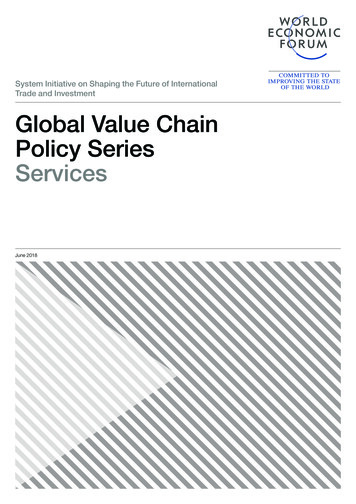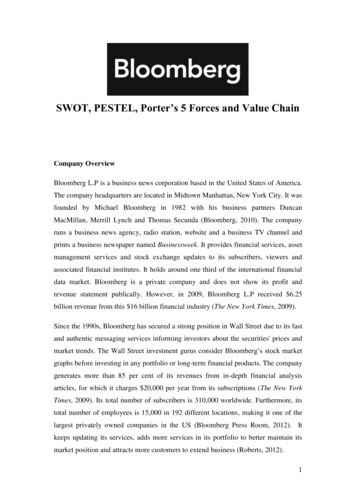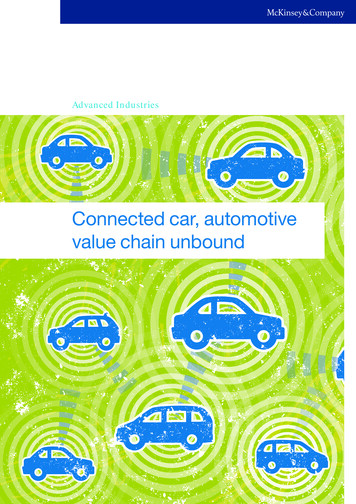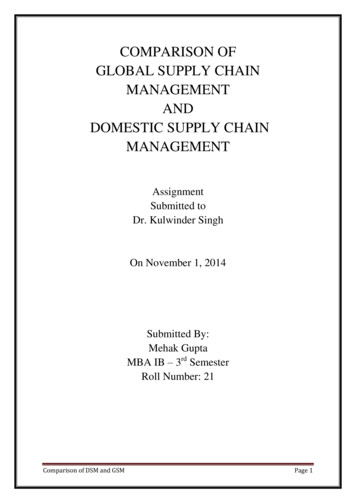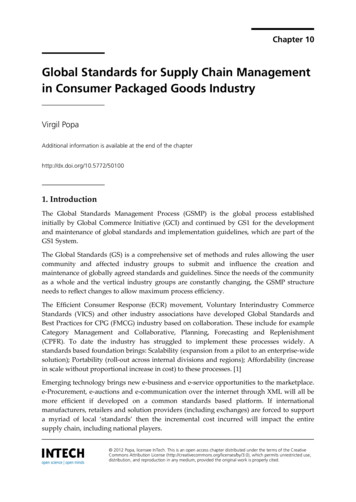
Transcription
Global Value Chain Analysis onSamsung ElectronicsFebruary 2012The Commercial Section of the Canadian Embassy in the Republic of Koreacommissioned this report to the Korea Associates Business Consultancy Ltd.(www.kabcltd.com)Readers should take note that the Government of Canada does not guarantee theaccuracy of any of the information contained in this report, nor does it necessarilyendorse the organizations listed herein. Readers should independently verify theaccuracy and reliability of the information.Page 1
Table of ContentsTable of Contents . 21.Executive Summary . 51.1.Purpose of the report. 51.2.Samsung Group and Samsung Electronics . 51.3.The Samsung Value Chain . 51.4.Mobile media and connected vehicles value chain. 61.4.1Mobile media . 61.4.2Connected vehicles . 61.5.Affiliated companies to contact . 61.6.Contacting Samsung . 61.7.Tips for Canadian companies . 61.8.List of contacts. 62.Introduction . 72.1.Object of study. 72.2.How to approach Samsung . 72.3.Future Technology – Mobile Media and Connected Vehicles . 73.Company Overview . 83.1.Samsung Group . 83.2.Samsung Electronics Corporation . 83.2.1. Management Structure by Product and Region . 83.2.2. Samsung Overseas . 93.2.3. Business description: financial summary . 103.3.Samsung Electronics’ product groups’ performance 2011 YOY . 124.The Basic Global Value Chain of Samsung Electronics . 134.1.Basic Value Chain . 134.2.Structure of the R&D Value Chain. 134.2.1. Samsung's R&D organisation. . 144.3.Procurement . 164.4.Logistics. 174.5.Assembly . 174.6.Trading support service and outbound logistics . 184.7.Marketing and Sales . 184.8.After-sales . 194.9.Support Activities . 204.10.Samsung Product Lifecycle management. 205.Value Chains of Mobile Media and Connected Vehicles. 235.1.Overview – the theory of convergence . 235.1.1. Overview R&D and Product Development . 23Page 2
3.6.5.3.7.5.3.8.5.3.9.Patents . 26Decision making criteria and decision trees related to becoming a researchpartner . 26Mobile Technology Value Chain . 26Overview . 26The Mobile Media Value Chain . 27Product and technology development. 27Sourcing decision making criteria . 27Components . 28Assembly points . 29Marketing and sales companies . 29After-service . 29Connected vehicles value chain . 29Basic Overview – the vision . 29Product and technology development. 31Decision making criteria and networks . 31Sourcing decision making criteria . 32Components . 33Assembly points . 33Marketing and Sales . 33After service . 33Patents . 336.Identification of Samsung Electronics’ affiliates and spin-offs within mobilemedia and connected vehicles areas . 346.1.Overview . 346.2.Korean based . 346.2.1. Product development: . 346.2.2. Production . 346.3.Other countries . 356.3.1. Product development . 356.3.2. Production . 357.Recommendations to Canadian companies for participation in Samsung’sglobal value chain for mobile media and connected vehicles areas . 367.1.Basic principles for participation . 367.2.Formal registration systems . 367.3.Beyond participation - seeking Samsung’s investment . 367.4.Joint research or problem solving . 377.4.1. SAIT Global Research Outreach Programme . 377.4.2. Core Network Program – Global Expert Network at SAIT . 387.5.Collaboration with other partners working with Samsung . 387.6.Best practises in supplying to Samsung . 387.7.Overview of entrance gates to Samsung’s Partnership . 39Page 3
8.Tips for Canadian Companies approaching Samsung . 408.1.Overview . 408.2.Hiring ex-Samsung people . 408.3.10 best entry points for Canadian companies . 409.Appendix with further details and contacts . 429.1.Research Proposal to GROW outreach contact: . 429.2.Samsung Technology Sourcing Collaboration (STSC) . 429.3.Samsung LTE, Mobile WiMAX . 429.4.Samsung Venture Investment . 429.5.Seoul Commtech. 429.6.Samsung SDS . 42Page 4
1. Executive Summary1.1.Purpose of the reportThe objective of this work is to produce a global value chain report on SamsungElectronics Corporation (SEC) which has two divisions in the information andcommunication technologies section, mobile media and connected vehicle development,with the aim of outlining innovation entry points for Canadian companies by identifyingSamsung’s organizational structure, and how Canadians, especially SMEs, can engage inthe various stages of Samsung Electronics’ value chain.1.2.Samsung Group and Samsung ElectronicsSamsung Group is the largest group or Chaebol in Korea. Samsung Electronics is thelargest subsidiary with a 2011 Korean consolidated income of C 150 billion. SamsungElectronics has 144 consolidated subsidiaries of which 18 were newly consolidated at theend of 2011. Samsung Electronics consists of three core divisions: 1.3.Device Solutions, a Business to Business (B2B) division handling semiconductors,other chips and Liquid Crystal Display (LCD) and other components.Digital Media & Communications (DM&C) is basically a Business to Consumer(B2C) Company producing phones, computers and televisions and everything inbetween.Samsung Advanced Institute of Technology (SAIT) is the research power ofSamsung that also handles (at the moment) new business.The two business divisions handle nine product divisions.The Samsung Value ChainAs a hi-tech company, Samsung Electronics and affiliates are determined to maintainleadership in all areas related to mobile and media technologies. The intellectualspearhead of this is Samsung Advanced Institute of Technology (SAIT). The way inwhich this institute and its related organs around the world begin the preparation for thedevelopment of new products is the first of the three layers of product development. Thenext two are at the centre of the Digital Media and Communications division and at eachproduct division.Procurement of components is in principle based around Samsung Electronics DeviceSolution division and affiliates. Products not made by this division are procured througha transparent process. These are then assembled in the appropriate factories of thedivision around the world.Device Solutions and Digital Media divisions divide into two, one as a B2B operationwith marketing and logistics focused on Korean and Incheon airport, and the other as aB2C company with a sophisticated logistics and global Enterprise Research Planning(ERP) system managed by Samsung Electronics Logitech and Samsung Digital System(SDS). Sales and Marketing come under a different management structure, which isbased on geographic area, rather than product, working with outsourced logistics andPage 5
vendors in each market. In 2007, Samsung was ranked 7th out of the 25 leadingcompanies for its integration in this field.1.4.Mobile media and connected vehicles value chain1.4.1 Mobile mediaA further section in this report looks at the value chain from the point of view of themobile product division, tracing each step for the basic vision, and analysing the R&Dsystem in depth and noting that production is heavily concentrated in Korea, China, andVietnam triangle. Sourcing decision trees for research and products includes mobileproducts, most especially the smart pad form building blocks for connected vehicles.1.4.2 Connected vehiclesThe value chain of connected vehicles is a forward looking construction that highlightsthe fact that product development is the key and the evolving eco-system has a muchhigher degree of outsourcing at this stage. Likewise the final product will be sharedamong B2B relations with Original Equipment Manufacturers (OEMs), consumers andsystem integrators like SDS. The role of Seoul Commtech, Samsung’s navigationcompany is emphasis
Samsung’s organizational structure, and how Canadians, especially SMEs, can engage in the various stages of Samsung Electronics’ value chain. 1.2. Samsung Group and Samsung Electronics Samsung Group is the largest group or Chaebol in Korea. Samsung Electronics is the largest subsidiary with a 2011 Korean consolidated income of C 150 billion. Samsung
